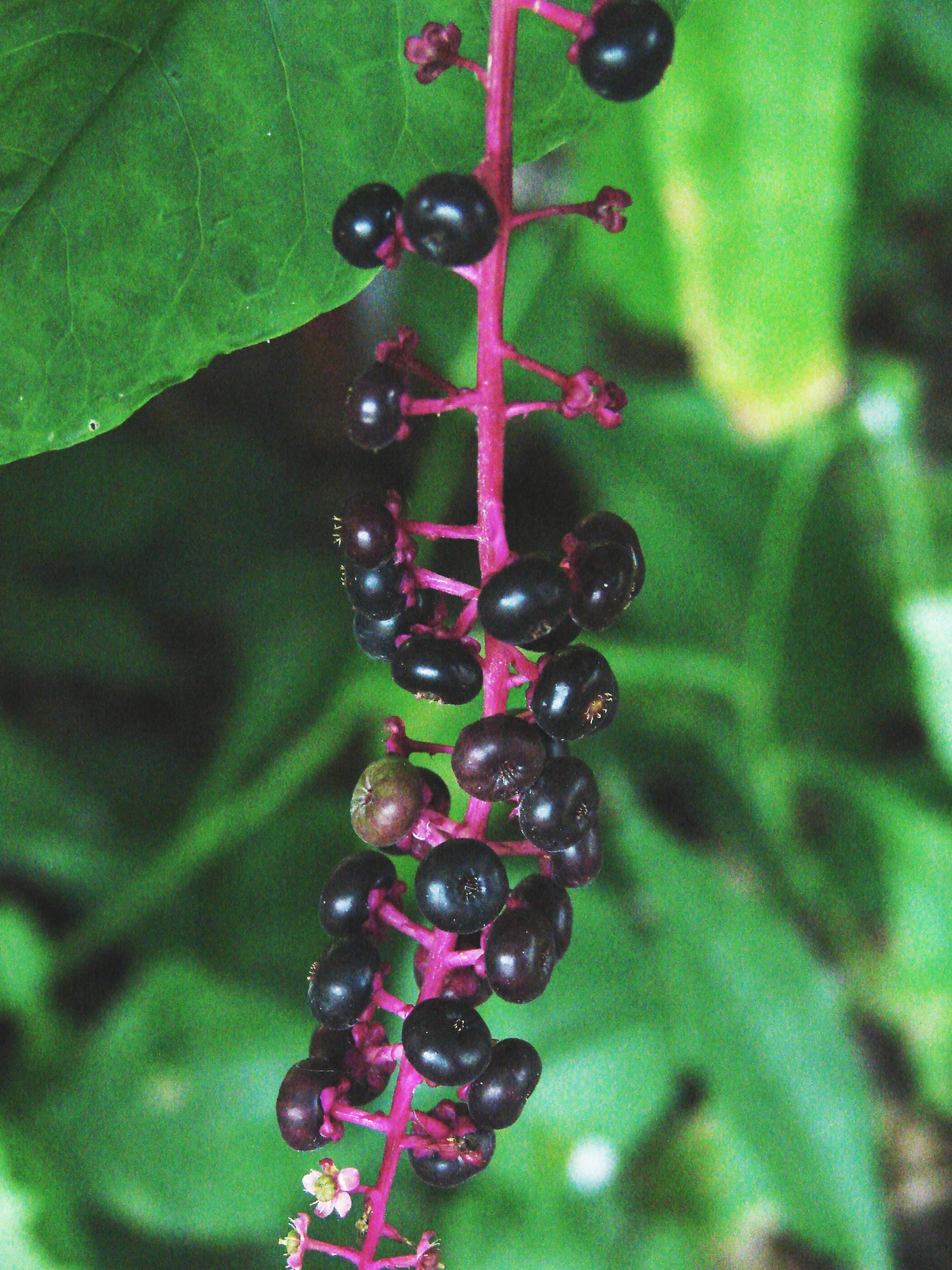- Pokeweed
Taxobox
color = lightgreen
name = Pokeweed

image_width = 240px
image_caption =
regnum =Plant ae
divisio = Magnoliophyta
classis =Magnoliopsida
ordo =Caryophyllales
familia =Phytolaccaceae
genus = "Phytolacca"
subdivision_ranks =Species
subdivision = About 35, including:
* "P. acinosa" (Southeast Asia)
* "P. americana" (North America)
* "P. clavigera" (China)
* "P. dioica" (South America)
* "P. decandra"
* "P. dodecandra" (Ethiopia)
* "P. esculenta" (East Asia)
* "P. heteropetala" (Mexico)
* "P. icosandra" (South America)
* "P. octandra" (New Zealand)"For the Hawaiian fish salad, seePoke (food) ."The pokeweeds, also known as poke, pokebush, pokeberry, pokeroot, polk salad, polk sallet, inkberry or ombú, comprise the
genus "Phytolacca",perennial plant s native toNorth America ,South America ,East Asia andNew Zealand . Pokeweed contains "phytolaccatoxin " and "phytolaccigenin ", which are poisonous tomammal s. However, the berries are eaten by birds, which are not affected by thetoxin because the small seeds with very hard outer shells remain intact in the digestive system and are eliminated whole.Pokeweeds are
herb s growing from 1 to 10 ft. tall. They have single alternate leaves, pointed at the end, with crinkled edges. The stems are often pink or red. Theflower s are greenish-white, in long clusters at the ends of the stems. They develop into dark purple berries."Phytolacca dioica", the
ombú , grows as a tree on thepampas of South America and is one of the few providers of shade on the open grassland. It is a symbol ofArgentina andgaucho culture.Uses
Young pokeweed leaves can be boiled three times to reduce the toxin, discarding the water after each boiling. The result is known as "poke salit", or "poke salad", and is occasionally available commercially. [cite web | last = Armstrong | first=Wayne | title=Pokeweed: An Interesting American Vegetable| url=http://waynesword.palomar.edu/ecoph24.htm | accessdate = 2007-07-21] Many authorities advise against eating pokeweed even after thrice boiling, as traces of the toxin may still remain. For many decades, poke salad has been a staple of
southern U.S. cuisine , despite campaigns by doctors who believed pokeweed remained toxic even after being boiled. The lingering cultural significance of Poke salad can be found in the 1969 hit song "Polk Salad Annie ," written and performed byTony Joe White , and famously covered byElvis Presley and the El Orbits. Pokeberry juice is added to other juices for jelly by those who believe it can relieve the pain of arthritis. There is a poke salad festival held annually in Gainesboro, TN.
Pokeweed is used as a folk remedy to treat many ailments. It can be applied topically or taken internally. Topical treatments have been used for acne and other ailments. Internal treatments include
tonsilitis , swollen glands and weight loss. Grated pokeroot was used by Native Americans as a poultice to treat inflammations and rashes of the breast.Pokeweed berries yield a red
ink ordye , which was once used by Native Americans to decorate theirhorse s. TheUnited States Declaration of Independence was written in fermented pokeberry juice (hence the common name 'inkberry'). Many letters written home during theAmerican Civil War were written in pokeberry ink; the writing in these surviving letters appears brown. The red juice has also been used to symbolize blood, as in the anti-slavery protest ofBenjamin Lay . A rich brown dye can be made by soaking fabrics in fermenting berries in a hollowed-outpumpkin .Some pokeweeds are also grown as
ornamental plant s, mainly for their attractive berries; a number ofcultivar s have been selected for larger fruit panicles.Pokeweeds are used as food plants by the
larva e of someLepidoptera species includingGiant Leopard Moth .Toxic Principle
Saponins , believed to be the primary toxic constituents, are present in the berry juice and other parts. Other toxic constituents have also been identified including the alkaloidphytolaccine (in small amounts) and the alkaloidphytolaccotoxin , as well as aglycoprotein . When pokeweed is used as food, the water in which it is boiled must be discarded.Clinical signs :" In humans:" The eating of nonfatal quantities of poke, perhaps of the shoots, may cause retching or vomiting after two hours or more. These signs may be followed by dyspnea, perspiration, spasms, severe purging, prostration, tremors, watery diarrhea (often bloody) and, sometimes, convulsions. If a fatal quantity is eaten, perhaps including roots, the above signs are followed by paralysis of the respiratory organs and other narcotic effects, culminating in the death of the poisoned person.
:"In horses:"Colic, diarrhea, respiratory failure.
:"In swine:" Unsteadiness, inability to rise, wretching. Jerking movements of the legs. Subnormal temperature. :"In cattle:" Same general signs plus a decrease in milk production.
Notes and references
ee also
*
Puccoon
*List of plants poisonous to equines
Wikimedia Foundation. 2010.
